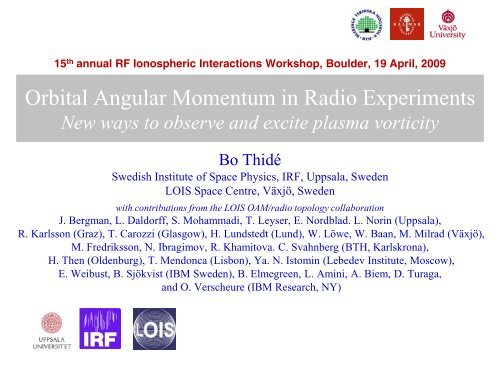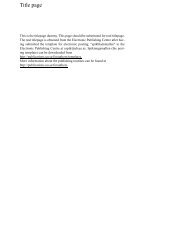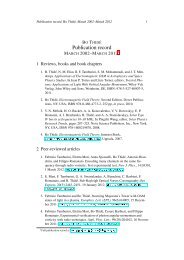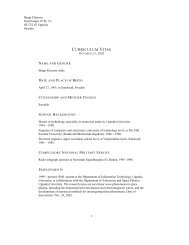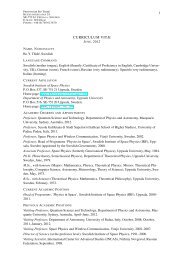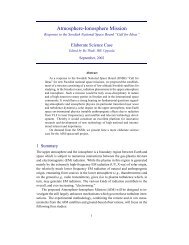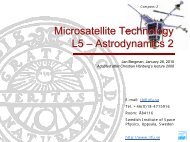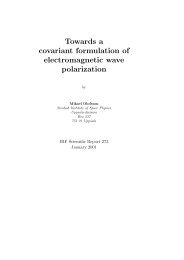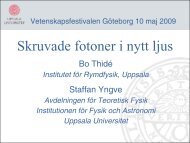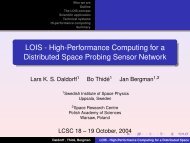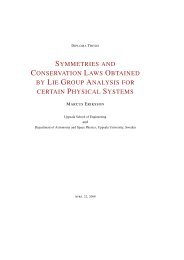Orbital Angular Momentum in Radio Experiments - Swedish Institute ...
Orbital Angular Momentum in Radio Experiments - Swedish Institute ...
Orbital Angular Momentum in Radio Experiments - Swedish Institute ...
You also want an ePaper? Increase the reach of your titles
YUMPU automatically turns print PDFs into web optimized ePapers that Google loves.
15 th annual RF Ionospheric Interactions Workshop, Boulder, 19 April, 2009<br />
<strong>Orbital</strong> <strong>Angular</strong> <strong>Momentum</strong> <strong>in</strong> <strong>Radio</strong> <strong>Experiments</strong><br />
New ways to observe and excite plasma vorticity<br />
Bo Thidé<br />
<strong>Swedish</strong> <strong>Institute</strong> of Space Physics, IRF, Uppsala, Sweden<br />
LOIS Space Centre, Växjö, Sweden<br />
with contributions from the LOIS OAM/radio topology collaboration<br />
J. Bergman, L. Daldorff, S. Mohammadi, T. Leyser, E. Nordblad. L. Nor<strong>in</strong> (Uppsala),<br />
R. Karlsson (Graz), T. Carozzi (Glasgow), H. Lundstedt (Lund), W. Löwe, W. Baan, M. Milrad (Växjö),<br />
M. Fredriksson, N. Ibragimov, R. Khamitova. C. Svahnberg (BTH, Karlskrona),<br />
H. Then (Oldenburg), T. Mendonca (Lisbon), Ya. N. Istom<strong>in</strong> (Lebedev <strong>Institute</strong>, Moscow),<br />
E. Weibust, B. Sjökvist (IBM Sweden), B. Elmegreen, L. Am<strong>in</strong>i, A. Biem, D. Turaga,<br />
and O. Verscheure (IBM Research, NY)
SEE as an on-demand space plasma EM<br />
turbulence diagnostics<br />
Complements – and supplements – optics, radars, satellites,etc.<br />
BoThidé 15th annual RF Ionospheric Interactions Workshop, Boulder, 20 April, 2009<br />
2
Secondary HF radio emission dependence<br />
on primary HF radio frequency ce<br />
HF pump frequency swept cont<strong>in</strong>uously up and down across 4f at Sura, Russia<br />
BUM hysteresis<br />
HF excited secondary radiation (SEE) as recorded at the radio facility SURA near Nizhniy Novgorod,<br />
Russia, 1999. The HF pump frequency is swept across the ionospheric 4 th electron gyroharmonic.<br />
Pump<br />
60 kHz <br />
(Click for animation)<br />
4f<br />
5340 kHz ce<br />
5540 kHz<br />
BoThidé 15th annual RF Ionospheric Interactions Workshop, Boulder, 20 April, 2009<br />
3
First detection of angular momentum <strong>in</strong> SEE<br />
<strong>Experiments</strong> at HEATING, Tromsø, 1983<br />
Bo Thidé. Stimulated Electromagnetic Emission and nonl<strong>in</strong>ear wave-wave <strong>in</strong>teractions <strong>in</strong><br />
ionospheric heat<strong>in</strong>g experiments. In M. Q. Tran and M. L. Sawley, editors, Proceed<strong>in</strong>gs,<br />
Contributed Papers, International Conference on Plasma Physics, volume I, page 131,<br />
Lausanne, Switzerland, 27 June-3 July 1984. Centre de Recherche en Physique des<br />
Plasmas, Ecole Polytechnique Federal de Lausanne, CRPP-EPFL.<br />
Circular, (nearly) O-mode pump<strong>in</strong>g<br />
O mode SEE<br />
X mode SEE<br />
Bo Thidé 15th annual RF Ionospheric Interactions Workshop, Boulder, 20 April, 2009<br />
4
First full polarimetry studies of SEE<br />
<strong>Experiments</strong> at SURA,Vasil’sursk, September 1998<br />
Bo Thidé 15th annual RF Ionospheric Interactions Workshop, Boulder, 20 April, 2009<br />
5
Lorentz’s microscopic Maxwell equations<br />
for the EM field (1903)<br />
Symmetric under <strong>in</strong>homogeneous Lorentz transformations. The concomitant Lie<br />
group is the 10-dimensional Po<strong>in</strong>caré group P(10). Accord<strong>in</strong>g to Noether’s<br />
theorem there therefore exist 10 conserved EM quantities. In fact there are 25<br />
exact cont<strong>in</strong>uous symmetries/conserved quantities (<strong>in</strong> vacuo), plus an as yet<br />
unknown number of approximate, conservation laws [Ibragimov, 2008].<br />
Bo Thidé 15th annual RF Ionospheric Interactions Workshop, Boulder, 20 April, 2009<br />
6
Conserved quantities <strong>in</strong> a closed electromechanical<br />
system (matter + EM fields) [Boyer, 2005] (1)<br />
Homogeneity <strong>in</strong> time => conservation of system energy<br />
(no EMF, no radiation; cf. Poynt<strong>in</strong>g’s theorem):<br />
Homogeneity <strong>in</strong> space => conservation of system l<strong>in</strong>ear<br />
momentum (gives, e.g., rise to EM Doppler shift):<br />
Foundation of conventional ‘l<strong>in</strong>ear momentum’ radio.<br />
Bo Thidé 15th annual RF Ionospheric Interactions Workshop, Boulder, 20 April, 2009<br />
7
Conserved quantities <strong>in</strong> a closed electromechanical<br />
system (matter + EM fields) [Boyer, 2005] (2)<br />
Invariance under proper Lorentz transformations =><br />
conservation of system centre of energy:<br />
Isotropy <strong>in</strong> space => conservation of system angular<br />
momentum (gives rise to azimuthal Doppler shift):<br />
The first part is the mechanical angular momentum J mech .<br />
The second part is the EM angular momentum J em .<br />
Foundation of ‘angular momentum’ radio or ‘dual radio’.<br />
Bo Thidé 15th annual RF Ionospheric Interactions Workshop, Boulder, 20 April, 2009<br />
8
Total EM field angular momentum<br />
For radiation beams <strong>in</strong> free space, EM field angular momentum J em can<br />
be separated <strong>in</strong>to two parts (for x 0 = 0) [Jackson, 1998; Thidé, 2009]:<br />
For each s<strong>in</strong>gle Fourier mode <strong>in</strong> real-valued representation [van Enk &<br />
Nienhuis, 1992]:<br />
The first part is the EM sp<strong>in</strong> angular momentum (SAM) S em , a.k.a. wave<br />
polarisation, and the second part is the EM orbital angular momentum<br />
(OAM) L em .<br />
NB: In general, both EM l<strong>in</strong>ear momentum p em , and EM angular<br />
momentum J em = L em + S em are radiated all the way out to the far zone!<br />
Bo Thidé 15th annual RF Ionospheric Interactions Workshop, Boulder, 20 April, 2009<br />
9
Standard textbooks show that classical<br />
EM angular momentum is radiated<br />
all the way to <strong>in</strong>f<strong>in</strong>ity<br />
Bo Thidé 15th annual RF Ionospheric Interactions Workshop, Boulder, 20 April, 2009<br />
10
Difference between polarisation (SAM) and orbital<br />
angular momentum (OAM)<br />
Bo Thidé 15th annual RF Ionospheric Interactions Workshop, Boulder, 20 April, 2009<br />
11
Micromechanical action of SAM and OAM<br />
Particles of sizes 1–3 μm irradiated by SAM/OAM laser beams<br />
Sp<strong>in</strong> angular momentum s = 1 <strong>Orbital</strong> angular momentum l = 8<br />
Bo Thidé 15th annual RF Ionospheric Interactions Workshop, Boulder, 20 April, 2009<br />
12
Challenge: Ionospheric and atmospheric turbulence<br />
distort low-frequency radio signals from outer space<br />
Today it is possible to compensate (‘self-calibrate’) for amplitude and nons<strong>in</strong>gular<br />
phase distortion of signals propagation through the ionosphere. Data<br />
from observations at VLA (Very Large Array, NM, USA) at 74 MHz.<br />
Bo Thidé 15th annual RF Ionospheric Interactions Workshop, Boulder, 20 April, 2009<br />
13
Phase s<strong>in</strong>gularities (dislocations) are to be expected<br />
<strong>in</strong> radio beams propagat<strong>in</strong>g through space<br />
Bo Thidé 15th annual RF Ionospheric Interactions Workshop, Boulder, 20 April, 2009<br />
14
Impart<strong>in</strong>g OAM onto an EM beam (laser, mm wave)<br />
with the help of a spiral plate or hologram<br />
Bo Thidé 15th annual RF Ionospheric Interactions Workshop, Boulder, 20 April, 2009<br />
15
Prediction: Ionospheric and other space plasma<br />
turbulence can change the topology of radio signals<br />
Bo Thidé 15th annual RF Ionospheric Interactions Workshop, Boulder, 20 April, 2009<br />
16
Plasma vorticity couples to radio<br />
OAM => topological distortion<br />
PRL<br />
NPG<br />
Bo Thidé 15th annual RF Ionospheric Interactions Workshop, Boulder, 20 April, 2009<br />
17
Nonl<strong>in</strong>ear excitation of OAM <strong>in</strong> plasma<br />
PRL, <strong>in</strong> press<br />
Bo Thidé 15th annual RF Ionospheric Interactions Workshop, Boulder, 20 April, 2009<br />
18
Even neutr<strong>in</strong>o beams can be endowed with OAM!<br />
Bo Thidé 15th annual RF Ionospheric Interactions Workshop, Boulder, 20 April, 2009<br />
19
EM beam with circular polarisation (SAM) S but<br />
no orbital angular momentum (POAM) L<br />
Phase fronts (loci of constant phase)<br />
Optics (LG)<br />
<strong>Radio</strong><br />
M. J. Padgett, J. Leach et al., U. Glasgow, UK; Royal Society<br />
Sjöholm and Palmer, 2007<br />
Bo Thidé 15th annual RF Ionospheric Interactions Workshop, Boulder, 20 April, 2009<br />
20
Instantaneous field vectors across an antenna<br />
array for a radio beam with circular SAM<br />
Phase 0 deg<br />
Phase 45 deg<br />
Bo Thidé 15th annual RF Ionospheric Interactions Workshop, Boulder, 20 April, 2009<br />
21
EM beams on the same frequency but with different OAM<br />
would be orthogonal and not <strong>in</strong>terfere with each other<br />
Spiral<strong>in</strong>g Poynt<strong>in</strong>g/l<strong>in</strong>ear momentum (and OAM) vectors!<br />
l=+1<br />
l=+3<br />
l= -4<br />
Bo Thidé 22
Instantaneous field vectors <strong>in</strong> a cross section of<br />
a radio beam carry<strong>in</strong>g both SAM and OAM<br />
Phase 0 deg<br />
Phase 45 deg<br />
Bo Thidé 15th annual RF Ionospheric Interactions Workshop, Boulder, 20 April, 2009<br />
23
Three orthogonal dipole antennas sample E(t,x)<br />
Three orthogonal loop antennas sample B(t,x)<br />
Bo Thidé 15th annual RF Ionospheric Interactions Workshop, Boulder, 20 April, 2009<br />
24
3D vector antennas allow new types of diagnostics<br />
Bo Thidé 15th annual RF Ionospheric Interactions Workshop, Boulder, 20 April, 2009<br />
25
LOIS radio idea: Sample the entire field vectors <strong>in</strong><br />
time and space (LOIS stn true superset of LOFAR stn)<br />
Bo Thidé 15th annual RF Ionospheric Interactions Workshop, Boulder, 20 April, 2009<br />
26
LOIS resources 2003–today (total ~ 2.5 MEur)<br />
Computer cluster (two SUR grants from IBM),<br />
currently <strong>in</strong> Uppsala. To be moved to Ronneby<br />
The control room at the LOIS Test Station Ris<strong>in</strong>ge/Växjö.<br />
<strong>Radio</strong> Sweden’s 500 kW transmitter located about<br />
100 km south of the Växjö LOIS test station and<br />
100 km south-west of the Ronneby prototype<br />
station site. Will be used for space radar tests.<br />
9m×8m×6m antenna chamber,<br />
Ångström Lab, Uppsala<br />
Magnetometer, LOIS Test<br />
Station, Ris<strong>in</strong>ge/Växjö<br />
Bo Thidé 15th annual RF Ionospheric Interactions Workshop, Boulder, 20 April, 2009<br />
27
LOIS prototype station under construction <strong>in</strong> Ronneby<br />
To be augmented by two outer, concentric r<strong>in</strong>gs, with 16 and 32 radio units,<br />
respectively, for a total of 56 units with three dipoles each (fund<strong>in</strong>g permitt<strong>in</strong>g)<br />
Bo Thidé 15th annual RF Ionospheric Interactions Workshop, Boulder, 20 April, 2009<br />
28
Mechanical effects of EM orbital angular momentum<br />
(OAM) predicted 1992<br />
Beth’s experiment, 1936<br />
Bo Thidé 15th annual RF Ionospheric Interactions Workshop, Boulder, 20 April, 2009<br />
29
<strong>Radio</strong> beams from circular antenna arrays<br />
can be made to carry OAM!<br />
Thidé et al., Phys. Rev. Lett., 99, 087701, 2007<br />
Bo Thidé 15th annual RF Ionospheric Interactions Workshop, Boulder, 20 April, 2009<br />
30
Field vector sens<strong>in</strong>g means total configurability<br />
Very good solar radio coronagraph!<br />
Bo Thidé 15th annual RF Ionospheric Interactions Workshop, Boulder, 20 April, 2009<br />
31
<strong>Radio</strong> beam topology degrees of freedom<br />
Conventional l<strong>in</strong>ear momentum (Poynt<strong>in</strong>g) flux and E<br />
Bo Thidé 15th annual RF Ionospheric Interactions Workshop, Boulder, 20 April, 2009<br />
32
The radio results agree with EM OAM theory<br />
Theory predicts that a circular polarised radio beam <strong>in</strong> a pure<br />
OAM eigenstate with azimuthal phase dependence exp(ilφ),<br />
frequency ω, and energy H, should have a total angular<br />
momentum component J z<br />
EM<br />
= lH/ω along the z (beam) axis.<br />
Bo Thidé 15th annual RF Ionospheric Interactions Workshop, Boulder, 20 April, 2009<br />
33
LOIS prototype station sensitivity<br />
48 tripoles=144 dipoles<br />
Bo Thidé 15th annual RF Ionospheric Interactions Workshop, Boulder, 20 April, 2009<br />
34
Very readable paper on POAM <strong>in</strong> astrophysics<br />
Bo Thidé 15th annual RF Ionospheric Interactions Workshop, Boulder, 20 April, 2009<br />
35
POAM <strong>in</strong> astronomy – A very recent and very<br />
comprehensive treatise<br />
Bo Thidé 15th annual RF Ionospheric Interactions Workshop, Boulder, 20 April, 2009<br />
36
2D LOFAR/SKA-type <strong>in</strong>terferometers exhibit<br />
polarisation aberration. 3D <strong>in</strong>terferometers do not<br />
Bo Thidé 15th annual RF Ionospheric Interactions Workshop, Boulder, 20 April, 2009<br />
37
Europe is lead<strong>in</strong>g the way<br />
Bo Thidé 15th annual RF Ionospheric Interactions Workshop, Boulder, 20 April, 2009<br />
38
Observations at 94 GHz of angular momentum<br />
<strong>in</strong>duced azimuthal (rotational ) Doppler shift<br />
Bo Thidé 15th annual RF Ionospheric Interactions Workshop, Boulder, 20 April, 2009<br />
39
Rotational Doppler shift spectrum<br />
Bo Thidé 15th annual RF Ionospheric Interactions Workshop, Boulder, 20 April, 2009<br />
40
Deep space radar requirements<br />
From Paul Rodriguez<br />
Bo Thidé 15th annual RF Ionospheric Interactions Workshop, Boulder, 20 April, 2009<br />
41
OAM spectrum prob<strong>in</strong>g (spiral imag<strong>in</strong>g) – a<br />
new radar diagnostic<br />
Recent digital spiral imag<strong>in</strong>g experiments (Ll. Torner et al., Opt. Express, 13, 873–881, 2005;<br />
Mol<strong>in</strong>a-Terriza et al., J. Eur. Opt. Soc., Rapid Publ., 2, 07014, 2007) have demonstrated that<br />
prob<strong>in</strong>g with OAM gives a wealth of new <strong>in</strong>formation about the object under study.<br />
The stimulus…<br />
Bo Thidé 15th annual RF Ionospheric Interactions Workshop, Boulder, 20 April, 2009<br />
42
Spiral (OAM) spectrum imag<strong>in</strong>g results<br />
…and its response<br />
Bo Thidé 15th annual RF Ionospheric Interactions Workshop, Boulder, 20 April, 2009<br />
43
OAM detection of <strong>in</strong>homogeneities (<strong>in</strong> transmission)<br />
Bo Thidé 15th annual RF Ionospheric Interactions Workshop, Boulder, 20 April, 2009<br />
44
EM vorticity/OAM as turbulence diagnostic<br />
Bo Thidé 15th annual RF Ionospheric Interactions Workshop, Boulder, 20 April, 2009<br />
45
OAM makes a new (spiral) frequency Ω available<br />
Interest<strong>in</strong>g consequences for radio communications<br />
Bo Thidé 15th annual RF Ionospheric Interactions Workshop, Boulder, 20 April, 2009<br />
46
S<strong>in</strong>gle photons can carry both sp<strong>in</strong> angular<br />
momentum S and orbital angular momentum L!<br />
Bo Thidé 15th annual RF Ionospheric Interactions Workshop, Boulder, 20 April, 2009<br />
47
Pack EM beams with much more data by<br />
utilis<strong>in</strong>g more topological degrees of freedom<br />
Bo Thidé 15th annual RF Ionospheric Interactions Workshop, Boulder, 20 April, 2009<br />
48
Hyperentangled SAM and OAM photon states break<br />
the l<strong>in</strong>ear-optics channel capacity threshold<br />
Bo Thidé 15th annual RF Ionospheric Interactions Workshop, Boulder, 20 April, 2009<br />
49
Shannon’s law revisited<br />
Bo Thidé 15th annual RF Ionospheric Interactions Workshop, Boulder, 20 April, 2009<br />
50
Photon OAM for observ<strong>in</strong>g black holes?<br />
Bo Thidé 15th annual RF Ionospheric Interactions Workshop, Boulder, 20 April, 2009<br />
51
New ideas – new audiences. SETI?<br />
‘…The <strong>in</strong>vestigation of new<br />
transmission modes by Thidé and<br />
Bergman h<strong>in</strong>ts that if we do f<strong>in</strong>d a<br />
signal from ET, we may wish to<br />
reconfigure our radio telescopes to<br />
look for encod<strong>in</strong>g of the message via<br />
such subtle effects as orbital angular<br />
momentum. A simple signal may only<br />
be a cipher for a more complex<br />
message, and there may be more<br />
th<strong>in</strong>gs <strong>in</strong> heaven and earth than even<br />
Maxwell had dreamt of …’<br />
Bo Thidé 15th annual RF Ionospheric Interactions Workshop, Boulder, 20 April, 2009<br />
52
Conclusions<br />
• Us<strong>in</strong>g all ‘degrees of freedom’ (conserved quantities)<br />
allows full characterization and extraction of all<br />
<strong>in</strong>formation carried by beams of EM waves/photons<br />
• Has already provided better diagnostics <strong>in</strong> laser<br />
physics and is enter<strong>in</strong>g free-space communications<br />
• Can use conventional radio techniques to apply these<br />
new results to the radio doma<strong>in</strong><br />
• The radio doma<strong>in</strong> results hold great promise for new<br />
fundamental optics and improved remote diagnostics<br />
• World’s first (?) OAM radio laboratory at Ångström<br />
Lab, Uppsala, is now com<strong>in</strong>g on l<strong>in</strong>e<br />
Bo Thidé 15th annual RF Ionospheric Interactions Workshop, Boulder, 20 April, 2009<br />
53
Thank you for your attention<br />
....there may be more th<strong>in</strong>gs <strong>in</strong> heaven and earth than even Maxwell had dreamt of …<br />
Bo Thidé 15th annual RF Ionospheric Interactions Workshop, Boulder, 20 April, 2009<br />
54
New ideas – detection of magnetic monopoles by<br />
measur<strong>in</strong>g the symmetry properties of the EM field?<br />
Bo Thidé 15th annual RF Ionospheric Interactions Workshop, Boulder, 20 April, 2009<br />
55
Radiation of power/l<strong>in</strong>ear momentum vs.<br />
radiation of angular momentum<br />
Outside (but not <strong>in</strong>side) the source<br />
region, the fields can be accurately<br />
approximated by an expansion <strong>in</strong><br />
spherical waves:<br />
The approximation (2) of approximation (1) is<br />
excellent for radiation of l<strong>in</strong>ear momentum<br />
(power, Poynt<strong>in</strong>g flux) but is completely<br />
wrong for radiation of angular momentum.<br />
The E R term excluded is the only term which<br />
gives rise to radiation of angular momentum!<br />
Bo Thidé 15th annual RF Ionospheric Interactions Workshop, Boulder, 20 April, 2009<br />
56
That far-zone POAM is generated by near-zone<br />
longitud<strong>in</strong>al E fields is well known s<strong>in</strong>ce 1914<br />
Bo Thidé 15th annual RF Ionospheric Interactions Workshop, Boulder, 20 April, 2009<br />
57
Sp<strong>in</strong>-off LOIS developments for space physics,<br />
astroparticle physics, and space communications<br />
Vector sens<strong>in</strong>g radio on a chip, 33×33 mm 2<br />
at 4 grammes based on bare die<br />
components on silicon<br />
Vector radio system for detection of<br />
UHE neutr<strong>in</strong>o <strong>in</strong>duced radio pulses <strong>in</strong><br />
the Antarctic ice<br />
Bo Thidé 15th annual RF Ionospheric Interactions Workshop, Boulder, 20 April, 2009<br />
58
LOIS physics idea: Space physics, space weather,<br />
solar radar, ionospheric turbulence ...<br />
Download from www.lois-space.net<br />
Bo Thidé 15th annual RF Ionospheric Interactions Workshop, Boulder, 20 April, 2009<br />
59


